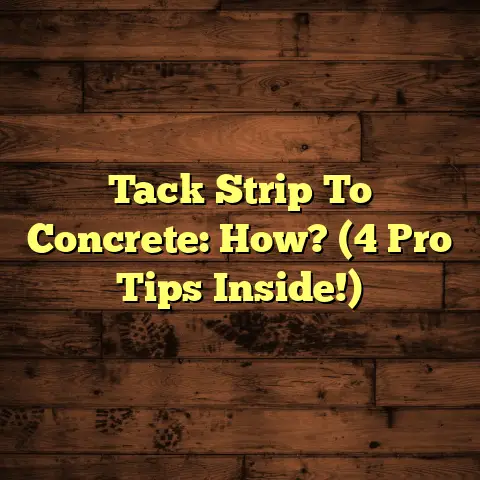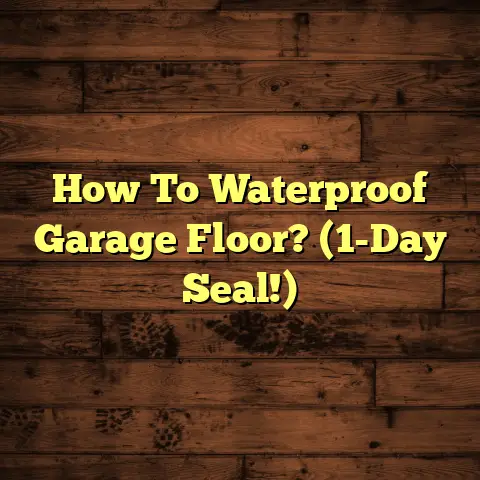Laminate Without Underlay? Read This! (3 Big Issues!)
I’m a flooring contractor, and let me tell you, flooring choices can make or break a property’s value.
Think about it: when you walk into a house, what’s one of the first things you notice?
The floors!
And in today’s market, laminate flooring is often seen as a budget-friendly way to get a nice look.
But here’s the thing: cutting corners can backfire.
I’ve seen it happen time and time again.
One of those tempting shortcuts?
Skipping the underlay beneath your laminate.
Now, I get it. Saving money is always appealing.
But trust me, as a flooring contractor, going without underlay can lead to some serious headaches.
And I’m not just talking about squeaky floors.
We’re talking about issues that can actually impact your home’s value when it’s time to sell.
In this article, I’m going to break down the three biggest problems you’ll face if you ditch the underlay.
We’ll cover everything from noise issues to moisture damage and even how comfortable your floors feel underfoot.
Think of this as your friendly guide to making sure your flooring investment pays off, not bites you in the butt!
Let’s dive in, shall we?
Issue #1 – Sound Insulation and Acoustics
The Importance of Sound Insulation
Ever walked into a room and felt like you were in an echo chamber? Not exactly relaxing, right?
That’s often the reality with laminate flooring installed directly on the subfloor without proper underlayment.
Laminate itself isn’t exactly known for its sound-dampening properties. It’s a hard surface, and hard surfaces reflect sound.
That means every footstep, every dropped object, every conversation can be amplified and transmitted.
This is where underlay comes in. A good quality underlay acts as a sound barrier, absorbing vibrations and reducing noise.
Think of it like a shock absorber for sound waves.
Without it, you’re essentially creating a drum, where every impact resonates throughout the room and beyond.
According to the National Association of Realtors, noise pollution is a growing concern for homebuyers.
In fact, studies have shown that homes in noisy areas can sell for up to 10% less than comparable properties.
And while that study might focus on external noise, the principle applies indoors as well.
A noisy house is simply less appealing to potential buyers.
The Buyer’s Perception
Imagine you’re a potential buyer walking through a house you’re considering.
You step onto the laminate floor, and clack, clack, clack, every footstep echoes through the room.
Your first impression?
The house feels cheap, unfinished, and frankly, annoying.
Sound plays a huge role in the overall ambiance of a home.
A quiet home feels peaceful, relaxing, and inviting.
A noisy home feels stressful, chaotic, and less desirable.
Buyers are increasingly aware of the importance of sound insulation, especially in multi-story homes or condos.
They don’t want to hear every footstep from upstairs or every conversation from the next room.
They want a sanctuary, a place where they can unwind and escape the noise of the outside world.
And if your floors are contributing to the noise, you’re already starting off on the wrong foot (pun intended!).
Long-term Implications on Resale Value
So, how does all of this impact your home’s resale value?
Well, let’s be honest, first impressions matter.
If potential buyers are turned off by the noise from your floors, they’re less likely to make an offer.
And even if they do, they’re likely to offer less than they would for a similar home with better sound insulation.
I’ve personally seen homes sit on the market for longer and ultimately sell for less simply because of noisy floors.
In one case, a client of mine installed laminate without underlay in their upstairs bedrooms to save money.
When it came time to sell, potential buyers complained about the noise transmission to the downstairs living area.
The clients ended up having to offer a $5,000 price reduction to compensate for the perceived defect.
That’s a pretty hefty price to pay for skipping the underlay!
And it’s not just about the immediate financial impact.
Poor sound insulation can also create a negative impression of the overall quality and maintenance of your home.
Buyers may assume that if you cut corners on the flooring, you’ve probably cut corners elsewhere as well.
This can lead to increased scrutiny during the inspection process and potentially more requests for repairs or price reductions.
So, if you’re thinking about skipping the underlay to save a few bucks, think again. It could end up costing you far more in the long run.
Issue #2 – Moisture Barrier and Floor Integrity
Understanding Moisture Control
Okay, let’s talk about something even scarier than noise: moisture.
Moisture is the enemy of any type of flooring, but especially laminate. Why?
Because laminate is primarily made of wood-based materials, which are highly susceptible to water damage.
This is where underlay comes in again.
A good underlay acts as a moisture barrier, preventing moisture from the subfloor from seeping into the laminate.
Think of it like a raincoat for your floors.
Without it, you’re leaving your laminate vulnerable to all sorts of problems.
Moisture can cause the laminate to warp, buckle, and even delaminate.
It can also create the perfect breeding ground for mold and mildew, which can lead to serious health problems and structural damage.
According to the Environmental Protection Agency (EPA), mold growth can begin within 24-48 hours of water exposure.
And once mold takes hold, it can be incredibly difficult and expensive to get rid of. We’re talking thousands of dollars!
Furthermore, excessive moisture can weaken the subfloor itself, leading to sagging, uneven floors and costly repairs.
The Impact on Home Value
So, how does moisture damage affect your home value?
Well, let’s put it this way: nobody wants to buy a house with moldy floors.
Moisture problems are a major red flag for potential buyers.
They know that moisture damage can be expensive to repair, and they’re worried about the potential health risks associated with mold.
A home with visible signs of moisture damage, such as warped flooring or musty odors, will almost certainly sell for less than a comparable property.
In fact, a study by the National Association of Home Builders found that homes with moisture problems sell for an average of 7% less.
That’s a significant chunk of change!
I’ve seen cases where homes with severe moisture damage have been virtually unsellable without extensive and costly remediation.
In one particularly memorable instance, a client of mine ignored my advice and installed laminate without underlay in their basement.
Within a few months, the laminate started to buckle and warp due to moisture seeping up from the concrete subfloor.
The client ended up having to rip out the entire floor, remediate the mold, and install a proper moisture barrier before they could even think about selling the house.
The whole ordeal cost them over $10,000 and delayed the sale by several months.
Buyer Concerns
Potential buyers are becoming increasingly savvy when it comes to flooring.
They’re doing their research, reading articles like this one, and educating themselves about the potential pitfalls of cheap flooring installations.
They know that flooring issues can be a sign of underlying problems, and they’re not afraid to walk away from a deal if they see red flags.
Buyers are particularly wary of homes with laminate flooring that appears to be poorly installed or maintained.
They’ll be looking for signs of moisture damage, such as warping, buckling, or discoloration.
They’ll also be sniffing for musty odors, which are a telltale sign of mold.
If they find any of these issues, they’re likely to demand a price reduction or even back out of the deal altogether.
According to a recent survey by Zillow, flooring issues are one of the top three things that deter buyers when viewing a home.
So, if you want to maximize your home’s resale value, it’s crucial to address any potential moisture problems before they become a deal-breaker.
And the easiest way to do that is to install a proper underlay beneath your laminate flooring.
Issue #3 – Comfort and Foot Traffic
The Importance of Comfort
Alright, we’ve covered sound and moisture.
Now let’s talk about something that might seem less critical, but is actually hugely important: comfort.
Think about it: you spend a lot of time walking on your floors.
So, shouldn’t they feel good underfoot?
Laminate flooring, on its own, can feel hard and unforgiving.
Walking on it for extended periods can lead to foot fatigue, joint pain, and even back problems.
A good underlay adds a layer of cushioning that makes the flooring feel softer and more comfortable to walk on.
It’s like adding a memory foam mattress topper to your bed.
It absorbs impact and reduces stress on your joints, making your home a more comfortable place to live.
Furthermore, underlay can help to insulate your floors, making them feel warmer in the winter and cooler in the summer.
This can improve your home’s energy efficiency and lower your utility bills.
Wear and Tear from Foot Traffic
Now, let’s talk about durability.
Laminate flooring is generally pretty tough, but it’s not indestructible.
Without underlay, the laminate is more susceptible to wear and tear from foot traffic.
Every time you walk on the floor, the laminate is being compressed against the hard subfloor.
Over time, this can cause the laminate to wear down, scratch, and even crack.
Underlay helps to distribute the weight and absorb the impact, reducing the stress on the laminate and extending its lifespan.
Think of it like a suspension system for your floors.
It protects the laminate from the constant pounding of foot traffic, keeping it looking newer for longer.
And the better your floors look, the higher your home’s resale value will be.
According to a study by the National Wood Flooring Association, well-maintained hardwood and laminate floors can increase a home’s value by up to 5%.
That’s a pretty good return on investment!
Buyer Expectations for Comfort
Today’s buyers are looking for more than just a pretty house.
They want a home that is comfortable, functional, and easy to maintain.
They want floors that feel good underfoot, that are durable, and that will stand the test of time.
They’re willing to pay a premium for these features, because they know that they’ll improve their quality of life.
Potential buyers will be paying attention to how the floors feel when they walk through your home.
They’ll be looking for signs of wear and tear, such as scratches, dents, and fading.
They’ll also be listening for squeaks and creaks, which can be a sign of underlying problems.
If your floors feel hard, uncomfortable, or worn out, buyers may be turned off and offer less for your home.
On the other hand, if your floors feel soft, comfortable, and well-maintained, buyers will be more impressed and willing to pay a higher price.
I’ve even had buyers specifically ask about the type of underlay used beneath the laminate flooring.
They know that a good underlay can make a big difference in the comfort and durability of the floors.
So, if you want to appeal to today’s discerning buyers, it’s essential to invest in a quality underlay for your laminate flooring.
Conclusion
Okay, we’ve covered a lot of ground here.
Let’s recap the three major issues you’ll face if you install laminate without underlay:
-
Sound Insulation: Noisy floors can deter potential buyers and decrease your home’s resale value.
-
Moisture Control: Moisture damage can lead to costly repairs, mold growth, and health problems.
-
Comfort and Foot Traffic: Hard, uncomfortable floors can make your home less appealing and reduce its value.
While the initial cost savings of skipping the underlay might seem attractive, the long-term consequences can be significant.
You could end up spending more money in the long run on repairs, remediation, and price reductions.
More importantly, you could be sacrificing the comfort, durability, and overall appeal of your home.
So, my advice is simple: don’t cut corners when it comes to your flooring.
Invest in a quality underlay and protect your investment.
Your floors (and your wallet) will thank you for it.
And when it comes time to sell your home, you’ll be glad you made the right choice.
Remember, your home is one of your biggest assets.
Treat it with respect, and it will reward you in the long run.
Now, go forth and make smart flooring decisions!





